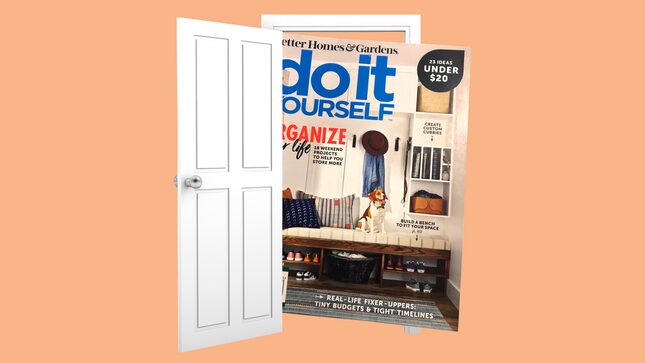
Graphic: Elena Scotti (Photos: Shutterstock, Better Homes & Gardens)
The cover of a Better Homes and Gardens “Do It Yourself” supplement makes a big promise: “Organize Your Life: 18 Weekend Projects to Help You Store More.” The image they’ve chosen to accompany the guide depicts an expansive entryway space with a custom bench, cubbies, and beautiful built-in storage. The bench has dedicated compartments for shoes and is topped with an inviting and attractive cushion—as well as, for some reason, throw pillows. At the edge of the frame is an open door; a woman’s jean jacket and leashes hang on dedicated hooks, with a cheerfully panting dog awaiting the viewer, presumably expecting a walk. It’s a perfect encapsulation of the fantasy entryway in American pop culture in 2020, which promises not merely a place to drop your bag but also a better life.
This cover image is one of many pages I’ve stuffed in a notebook of pages torn from shelter magazines, in hopes of one day having a more customizable living space. The idea was to minimize the number of glossies lying around my house—decluttering, the great obsession of our era—but it quickly became a focus for much of my middle-aged nesting obsession, since I rent and can’t exactly knock out a wall or install a butler’s pantry, even if I could justify the expense. Everything that catches my eye goes in the binder, and it’s now stuffed with every conceivable project—open shelving schemes for kitchens, creative bookcase arrangements, very loud wallpaper, cozy reading nooks. But I have become particularly obsessed with the most minor of rooms, meticulously organized: entryways, and more specifically mudrooms that have been reimagined as “drop zones,” which seem to promise not simply a cleaner house but a wholly better-arranged home and, frankly, a smoother-run life.
-

-

-

-

-

-

-

-

-

-

-

-

-

-

-

-

-

-

-

-

-

-

-

-

-

-

-

-

-

-

-

-

-

-

-

-

-

-

-

-








































